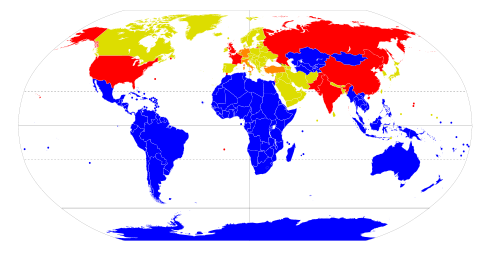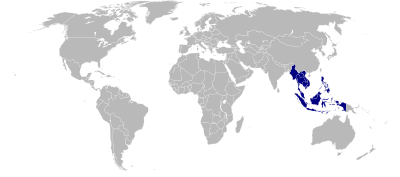
Southeast Asian Nuclear-Weapon-Free Zone Treaty
Encyclopedia


Nuclear-Weapon-Free Zone
A nuclear-weapons-free zone, or NWFZ is defined by the United Nations as an agreement which a group of states has freely established by treaty or convention, that bans the use, development, or deployment of nuclear weapons in a given area, that has mechanisms of verification and control to enforce...
Treaty (SEANWFZ) or the Bangkok Treaty of 1995, is a nuclear weapon
Nuclear weapon
A nuclear weapon is an explosive device that derives its destructive force from nuclear reactions, either fission or a combination of fission and fusion. Both reactions release vast quantities of energy from relatively small amounts of matter. The first fission bomb test released the same amount...
s moratorium treaty between 10 Southeast Asia
Southeast Asia
Southeast Asia, South-East Asia, South East Asia or Southeastern Asia is a subregion of Asia, consisting of the countries that are geographically south of China, east of India, west of New Guinea and north of Australia. The region lies on the intersection of geological plates, with heavy seismic...
n member-states under the auspices of the ASEAN: Brunei Darussalam, Cambodia
Cambodia
Cambodia , officially known as the Kingdom of Cambodia, is a country located in the southern portion of the Indochina Peninsula in Southeast Asia...
, Indonesia
Indonesia
Indonesia , officially the Republic of Indonesia , is a country in Southeast Asia and Oceania. Indonesia is an archipelago comprising approximately 13,000 islands. It has 33 provinces with over 238 million people, and is the world's fourth most populous country. Indonesia is a republic, with an...
, Laos
Laos
Laos Lao: ສາທາລະນະລັດ ປະຊາທິປະໄຕ ປະຊາຊົນລາວ Sathalanalat Paxathipatai Paxaxon Lao, officially the Lao People's Democratic Republic, is a landlocked country in Southeast Asia, bordered by Burma and China to the northwest, Vietnam to the east, Cambodia to the south and Thailand to the west...
, Malaysia, Myanmar
Myanmar
Burma , officially the Republic of the Union of Myanmar , is a country in Southeast Asia. Burma is bordered by China on the northeast, Laos on the east, Thailand on the southeast, Bangladesh on the west, India on the northwest, the Bay of Bengal to the southwest, and the Andaman Sea on the south....
, Philippines
Philippines
The Philippines , officially known as the Republic of the Philippines , is a country in Southeast Asia in the western Pacific Ocean. To its north across the Luzon Strait lies Taiwan. West across the South China Sea sits Vietnam...
, Singapore
Singapore
Singapore , officially the Republic of Singapore, is a Southeast Asian city-state off the southern tip of the Malay Peninsula, north of the equator. An island country made up of 63 islands, it is separated from Malaysia by the Straits of Johor to its north and from Indonesia's Riau Islands by the...
, Thailand
Thailand
Thailand , officially the Kingdom of Thailand , formerly known as Siam , is a country located at the centre of the Indochina peninsula and Southeast Asia. It is bordered to the north by Burma and Laos, to the east by Laos and Cambodia, to the south by the Gulf of Thailand and Malaysia, and to the...
, and Viet Nam.
It was opened for signature at the treaty conference in Bangkok
Bangkok
Bangkok is the capital and largest urban area city in Thailand. It is known in Thai as Krung Thep Maha Nakhon or simply Krung Thep , meaning "city of angels." The full name of Bangkok is Krung Thep Mahanakhon Amon Rattanakosin Mahintharayutthaya Mahadilok Phop Noppharat Ratchathani Burirom...
, Thailand
Thailand
Thailand , officially the Kingdom of Thailand , formerly known as Siam , is a country located at the centre of the Indochina peninsula and Southeast Asia. It is bordered to the north by Burma and Laos, to the east by Laos and Cambodia, to the south by the Gulf of Thailand and Malaysia, and to the...
, on 15 December, 1995 and it entered into force on March 28, 1997 and obliges its members not to develop, manufacture or otherwise acquire, possess or have control over nuclear weapons.
The Zone is the area comprising the territories of the states and their respective continental shelves and Exclusive Economic Zones (EEZ); "Territory" means the land territory, internal waters
Internal waters
A nation's internal waters covers all water and waterways on the landward side of the baseline from which a nation's territorial waters is defined. It includes waterways such as rivers and canals, and sometimes the water within small bays. According to the United Nations Convention on the Law of...
, territorial sea, archipelagic waters, the seabed and the sub-soil thereof and the airspace above them.
The treaty includes a protocol under which the five nuclear-weapon states recognized by the Treaty on the Non-Proliferation of Nuclear Weapons (NPT), namely China
People's Republic of China
China , officially the People's Republic of China , is the most populous country in the world, with over 1.3 billion citizens. Located in East Asia, the country covers approximately 9.6 million square kilometres...
, the United States
United States
The United States of America is a federal constitutional republic comprising fifty states and a federal district...
, France
France
The French Republic , The French Republic , The French Republic , (commonly known as France , is a unitary semi-presidential republic in Western Europe with several overseas territories and islands located on other continents and in the Indian, Pacific, and Atlantic oceans. Metropolitan France...
, Russia
Russia
Russia or , officially known as both Russia and the Russian Federation , is a country in northern Eurasia. It is a federal semi-presidential republic, comprising 83 federal subjects...
and the United Kingdom
United Kingdom
The United Kingdom of Great Britain and Northern IrelandIn the United Kingdom and Dependencies, other languages have been officially recognised as legitimate autochthonous languages under the European Charter for Regional or Minority Languages...
(who are also the five permanent members of the United Nations Security Council
United Nations Security Council
The United Nations Security Council is one of the principal organs of the United Nations and is charged with the maintenance of international peace and security. Its powers, outlined in the United Nations Charter, include the establishment of peacekeeping operations, the establishment of...
) undertake to respect the Treaty and do not contribute to a violation of it by State parties. None of the nuclear-weapon states have signed this protocol.
Background
The groundwork of the establishment of the future Southeast Asian Nuclear-Weapon-Free Zone Treaty (SEANWFZ) was started on November 27, 1971, when the 5 original members of the Association of Southeast Asian Nations (ASEAN), Indonesia, Malaysia, Philippines, Singapore, and Thailand, met in Kuala LumpurKuala Lumpur
Kuala Lumpur is the capital and the second largest city in Malaysia by population. The city proper, making up an area of , has a population of 1.4 million as of 2010. Greater Kuala Lumpur, also known as the Klang Valley, is an urban agglomeration of 7.2 million...
, Malaysia and signed the declaration on ASEAN's Zone of Peace, Freedom and Neutrality
Zone of Peace, Freedom and Neutrality
The Zone of Peace, Freedom and Neutrality is a declaration signed by the Foreign Ministers of the ASEAN member states on 27 November 1971 in Kuala Lumpur, Malaysia....
(ZOPFAN). One of the targets of ASEAN was also the establishment of SEANWFZ.
However, due to the political atmosphere at that time, including rivalries among the members and conflicts in the region and the Cold War
Cold War
The Cold War was the continuing state from roughly 1946 to 1991 of political conflict, military tension, proxy wars, and economic competition between the Communist World—primarily the Soviet Union and its satellite states and allies—and the powers of the Western world, primarily the United States...
, it was less feasible then to establish SEANWFZ. Thus the formal proposal for establishing a nuclear-free region was delayed until the 1990s
1990s
File:1990s decade montage.png|From left, clockwise: The Hubble Space Telescope floats in space after it was taken up in 1990; American F-16s and F-15s fly over burning oil fields and the USA Lexie in Operation Desert Storm, also known as the 1991 Gulf War; The signing of the Oslo Accords on...
, after the Cold War ended and conflicts were settled, and the member states renewed the denuclearization efforts. After conducting negotiations and finalizing the treaty for SEANWFZ by an ASEAN working group, the SEANWFZ treaty finally signed by the heads of government from 10 ASEAN member states in Bangkok on December 15, 1995. The treaty took effect on 28 March, 1997 after all but one of the member states have ratified it. It became fully effective on 21 June, 2001, after the Philippines ratified it, effectively banning all nuclear weapons in the region.
Membership
| State | Signed | Deposited |
 Brunei Brunei |
||
 Myanmar Myanmar |
||
 Cambodia Cambodia |
||
 Indonesia Indonesia |
||
 Laos Laos |
||
 Malaysia Malaysia |
||
 Philippines Philippines |
||
 Singapore Singapore |
||
 Thailand Thailand |
||
 Vietnam Vietnam |
Protocol
| State | Signed | Deposited |
 Mainland China Mainland China |
||
 Early Modern France Early Modern France |
||
 Russia Russia |
||
 United Kingdom United Kingdom |
||
 United States United States |
See also
- Nuclear-weapon-free zoneNuclear-Weapon-Free ZoneA nuclear-weapons-free zone, or NWFZ is defined by the United Nations as an agreement which a group of states has freely established by treaty or convention, that bans the use, development, or deployment of nuclear weapons in a given area, that has mechanisms of verification and control to enforce...
- Treaty on the Non-Proliferation of Nuclear Weapons
- Zone of Peace, Freedom and NeutralityZone of Peace, Freedom and NeutralityThe Zone of Peace, Freedom and Neutrality is a declaration signed by the Foreign Ministers of the ASEAN member states on 27 November 1971 in Kuala Lumpur, Malaysia....
- ASEAN
- Southeast AsiaSoutheast AsiaSoutheast Asia, South-East Asia, South East Asia or Southeastern Asia is a subregion of Asia, consisting of the countries that are geographically south of China, east of India, west of New Guinea and north of Australia. The region lies on the intersection of geological plates, with heavy seismic...

